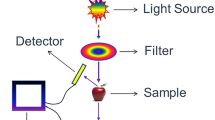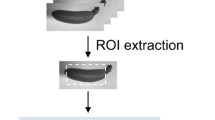Abstract
In this study, the applicability of hyperspectral technique, a fast and non-destructive, novel method was investigated for the color discrimination of avocados subjected to different treatments. Fruits like avocados are coated with edible films to extend their shelf life. Using different formulations of coating with varying pectin, beeswax, and sorbitol contents, nine different coating preparations with potential to influence the ripening behavior of avocados were developed. Avocados were coated with these formulations, air-dried, and stored at room temperature. Concurrently, the reflectance responses of the avocado fruits were measured in 2,151 wavebands (350 to 2500 nm) with a field spectroradiometer. To tackle the co-linearity that exists between the spectral observations, aggregated 10- and 20-nm data sets were used. Using a stepwise procedure, the most effective wavebands capable of discriminating treatment effects were selected. By applying a discrimination procedure with a well-chosen subset of the selected wavebands, treatments were correctly classified with more than 92% accuracy.


Similar content being viewed by others
References
Bender, R.-J., Brecht, J.-K., Sargent, S.-A., Navarro, J.-C., & Campbell, C.-A. (1993). Ripening initiation and storage performance of avocados treated with an edible film coating. Acta Horticulturae, 343, 184–186.
Bostater, C.-R. (1998). Imaging derivative spectroscopy for vegetation dysfunction assessments. SPIE, 3499, 277–285.
Fathi, M., Mohebbi, M., & Ali Razavi, S. M. (2009) Application of image analysis and artificial neural network to predict mass transfer kinetics and color changes of osmotically dehydrated kiwifruit. Food and Bioprocess Technology. doi: 10.1007/s11947-009-0222-y
Johnson, D.-E. (1998). Applied multivariate methods for data analysts. Pacific Grove, CA: Brooks/Cole Publishing.
Johnston, J.-W., & Banks, N.-H. (1998). Selection of a surface coating and optimization of its concentration for use on ‘‘Hass’’ avocado (Persea americana Mill) fruit. New Zealand Journal of Crop and Horticultural Science, 26(2), 143–151.
Kader, A.-A. (1986). Biochemical and physiological basis for effects of controlled atmospheres on fruits and vegetables. Food Technology, 40, 99–100. 102–104.
Kang, S., Kim, M.-S., & Noh. S.-Ha. (2005). Hyperspectral imaging for detecting defect on apples. ASAE Paper No. 053075 Tampa, Florida, 17–20 July 2005.
Karimi, Y., Prasher, S.-O., Mcnairn, H., Bonnell, R.-B., Dutilleul, P., & Goel, P.-K. (2005). Discriminant analysis of hyperspectral data for assessing water and nitrogen stresses in corn. Transactions of the ASAE, 48(2), 805–813.
Kim, M.-S., Chen, Y.-R., & Mehl, P.-M. (2001). Hyperspectral reflectance and fluorescence imaging system for food quality and safety. Transactions of the ASAE, 44(3), 721–729.
Lu, R., Chen, Y.-R., Park, B., & Choi, K.-H. (1999). Hyperspectral imaging for detecting bruises in apples. ASAE Paper No. 993120. St. Joseph, MI: ASAE.
Maftoonazad, N., & Ramaswamy, H.-S. (2005). Postharvest shelf-life extension of avocados using methyl cellulose-based coating. LWT-Food Science and Technology, 38(6), 617–624.
Maftoonazad, N., Ramaswamy, H.-S., & Marcotte, M. (2007a). Evaluation of factors affecting barrier, mechanical and optical properties of pectin-based films using response surface methodology. Journal of Food Process Engineering, 30(5), 539–563.
Maftoonazad, N., Ramaswamy, H.-S., Marcotte, M. (2007b). Moisture sorption behavior, and effect of moisture content and sorbitol on thermo-mechanical and barrier properties of pectin based edible films. International Journal of Food Engineering, 3(4), art. no. 10. doi: 10.2202/1556-3758.1137.
Maftoonazad, N., Ramaswamy, H.-S., Moalemiyan, M., & Kushalappa, A.-C. (2007c). Effect of pectin-based edible emulsion coating on changes in quality of avocado exposed to Lasiodiplodia theobromae infection. Carbohydrate Polymers, 68(2), 341–349.
Mehl, P.-M., Chao, K., Kim, M., & Chen, Y.-R. (2002). Detection of defects on selected apple cultivars using hyperspectral and multispectral image analysis. Applied engineering in agriculture, 18(2), 219–226.
Menesatti, P., Zanella, A., D’Andrea, S., Costa, C., Paglia, G., & Pallottino1 F. (2009) Supervised multivariate analysis of hyper-spectral NIR images to evaluate the starch index of apples. Food and Bioprocess Technology (online). doi: 10.1007/s11947-008-0120-8.
Murray, G.-D. (1977). A cautionary note on selection of variables in discriminant analysis. Applied Statistics, 26(3), 246–250.
Polder, G., van der Heijden, G.-W.-A.-M., Young, I.-T, (2000). Hyperspectral image analysis for measuring ripeness of tomatoes. ASAE Paper No. 003089. St. Joseph, MI: ASAE
Salvador, L., Miranda, S.-P., Aragon, N., & Lara, V. (1999). Chitosan coating on avocado fruit. The Revista de la Sociedad Quimica de Mexico, 43(1), 18–23.
Scott, K.-J., & Chaplin, G.-R. (1978). Reduction of chilling injury in avocado stored in sealed polyethylene bags. Tropical Agriculture (Trinidad), 55, 87–90.
Shenderey, C., Shmulevich, I., Alchanatis, V., Egozi, H., Hoffman, A., Ostrovsky, O., et al. (2009). NIRS detection of moldy core in apples. Food and Bioprocess Technology (online). doi 10.1007/s11947-009-0256-1
Delwiche, S.-R., & Kim, M.-S. (2000). Hyperspectral imaging for detection of scab in wheat. SPIE, 4203, 13–20.
Tsuta, M., Sugiyama, J., & Sagara, Y. (2002). Near-infrared imaging spectroscopy based on sugar absorption for melons. Journal of Agricultural Food Chemistry, 50(1), 48–52.
Vrindts, E., De Baerdemaeker, J., & Ramon, H. (2002). Weed detection using canopy reflection. Precision Agriculture, 3(1), 63–68.
Yahia, E.-M., & Gonzalez-Aguilar, G. (1998). Use of passive and semiactive atmospheres to prolong the postharvest life of avocado fruit. Lebensmittel Wissenschaft und Technologie Food Science and Technology, 31, 602–606.
Author information
Authors and Affiliations
Corresponding author
Rights and permissions
About this article
Cite this article
Karimi, Y., Maftoonazad, N., Ramaswamy, H.S. et al. Application of Hyperspectral Technique for Color Classification Avocados Subjected to Different Treatments. Food Bioprocess Technol 5, 252–264 (2012). https://doi.org/10.1007/s11947-009-0292-x
Received:
Accepted:
Published:
Issue Date:
DOI: https://doi.org/10.1007/s11947-009-0292-x




